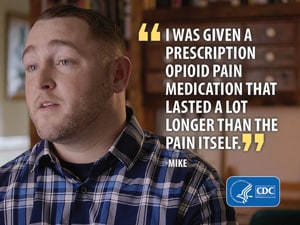Prevent Opioid Misuse

Learn about Mike’s journey from injury to recovery.
If you are prescribed opioids for your pain, you have the following responsibilities to help ensure you are getting the safest, most effective pain management possible.
What You Can Do to Prevent Opioid Misuse
Work with Your Doctor
- Work with your doctor to create a plan on how to manage your pain.
- Know your options and consider ways to manage your pain that do not include opioids.
- Talk to your doctor about any and all side effects and concerns.
- Make the most informed decision with your doctor.
- Follow up regularly with your doctor.
Take and Store Opioids Properly
- Never take prescription opioids in greater amounts or more often than prescribed.
- Always let your doctor know about any side effects or concerns you may have about using opioids.
- Avoid taking opioids with alcohol and other substances or medications. It is very dangerous to combine opioids with other drugs, especially those that cause drowsiness:
- Benzodiazepines (such as Xanax® and Valium®)
- Muscle relaxants (such as Soma® or Flexeril®)
- Hypnotics (such as Ambien® or Lunesta®)
- Other prescription opioids
- Do not share or sell your prescription opioids.
- Store prescription opioids in a secure place, out of reach of others (including children, family, friends, and visitors).
- If you have unused prescription opioids at the end of your treatment, find your community drug take-back program or your pharmacy mail-back program, or flush them down the toilet, following guidance from the Food and Drug Administration.
Find Help and Treatment
If you or someone close to you needs help for a substance use disorder, talk to your doctor or call SAMHSA’s National Helpline at 1-800-662-HELP or go to SAMHSA’s Behavioral Health Treatment Services Locator.
Additional Resources
